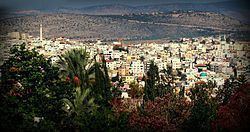Founded Bronze Age (as Sogane) Local time Wednesday 9:05 AM | Area 9.7 km² Team Bnei Sakhnin F.C. | |
 | ||
Name meaning Sukhnin, from personal name, Weather 15°C, Wind E at 6 km/h, 72% Humidity | ||
Karate israel sakhnin 2016 juergen mayer
Sakhnin (Arabic: سخنين; Hebrew: סַחְ'נִין or סִכְנִין Sikhnin) is an Arab city in Israel's Northern District. It is located in the Lower Galilee, about 23 kilometres (14 mi) east of Acre. Sakhnin was declared a city in 1995. In 2015 its population was 29,316, mostly Muslim with a sizable Christian minority. Sakhnin is home to the largest population of Sufi Muslims within Israel, with approximately 80 members.
Contents
- Karate israel sakhnin 2016 juergen mayer
- Map of Sakhnin Israel
- Geography
- History
- Ottoman era
- British Mandate era
- State of Israel
- Sports
- References
Map of Sakhnin, Israel
Geography
Sakhnin is built over three hills and is located in a valley surrounded by mountains, the highest one being 602 meters high. Its rural landscape is almost entirely covered by olive and fig groves as well as oregano and sesame shrubs.
History
Settlement at Sakhnin dates back 3,500 years to its first mention in 1479 BCE by Thutmose II, whose ancient Egyptian records mention it as a centre for production of indigo dye. Sargon II also makes mention of it as Suginin.
Sakhnin is situated on an ancient site, where remains from columns and cisterns have been found. It was mentioned as Sogane, a town fortified in 66, by Josephus. A cistern, excavated near the mosque in the old city centre, revealed pottery fragments dating from the 1st to the 5th century CE.
In the Crusader era, it was known as Zecanin. In 1174 it was one of the casales (villages) given to Phillipe le Rous. In 1236 descendants of Phillipe le Rous confirmed the sale of the fief of Saknin.
Ottoman era
In 1596, Sakhnin appeared in Ottoman tax registers as being in the Nahiya of Akka of the Liwa of Safad. It had a population of 66 households and 8 bachelors, all Muslim. It paid taxes on wheat, barley, olives, cotton, and a water mill.
In 1859 the British Consul Rogers estimated the population to be 1,100, and the cultivated area 100 feddans, while in 1875 Victor Guérin found 700 inhabitant, both Muslims, Greek Orthodox and ”Schismatic Greek".
In 1881, the Palestine Exploration Fund's Survey of Western Palestine (SWP) described Sakhnin as follows: "A large village of stone and mud, amid fine olive-groves, with a small mosque. The water supply is from a large pool about half a mile to the south-east. The inhabitants are Moslems and Christians".
British Mandate era
In a census conducted in 1922 by the British Mandate authorities, Kabul had a population of 1,575; 1,367 Muslims and 208 Christians; 87 Orthodox and 121 Greek Catholic (Melchite). The population increased in the 1931 census to a total of 1,891; 1688 Muslims, 202 Christians, and 1 Jew, in a total of 400 houses.
By 1945, Sakhnin had 2,600 inhabitants; 2310 Muslims and 290 Christians. The total jurisdiction of the village was 70,192 dunams of land. 3,622 dunams were used for plantations and irrigable land, 29,366 dunams for cereals, while 169 dunams were built-up (urban) land.
State of Israel
During the 1948 Arab-Israeli war, Sakhnin surrendered to Israeli forces on July 18, 1948, during Operation Dekel, but was re-captured by Arab forces shortly afterwards. It finally fell without battle during Operation Hiram, 29–31 October 1948. Many of the inhabitants fled north but some stayed and were not expelled by the Israeli soldiers. The town remained under Martial Law until 1966.
In 1976, it became the site of the first Land Day marches, in which six Israeli Arabs were killed by Israeli forces during violent protests of government confiscation of 5,000 acres (20 km2) of Arab-owned land near Sakhnin. And in 1976 three more civilians were killed during clashes with the police, and in Jerusalem and the Aqsa Intifada in 2000 two men were killed.
Sports
In 2003, the town's football club, Bnei Sakhnin, became one of the first Arab teams to play in the Israeli Premier League, the top tier of Israeli football. The following year, the club won the State Cup, and was the first Arab team to do so; consequently, it participated in the UEFA Cup the following season, losing out to Newcastle United. The team received a new home with the 2005 opening of Doha Stadium, funded by the Israeli government and the Qatar National Olympic Committee, whose capital it is named after. The stadium has a capacity of 5,000.
Sakhnin is also the hometown of Abbas Suan, an Israeli international footballer who previously played for Bnei Sakhnin. The town and their soccer team are the subject of the 2010 documentary film After The Cup: Sons of Sakhnin United
On 19 September 2008, Bnei Sakhnin played a game with the Spanish team Deportivo de La Coruña.
